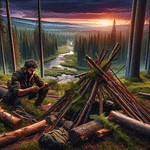How to build an igloo for overnight snow camping
Hello there! Welcome to the Northwest Sisu Outdoors YouTube channel!I hope you are doing great today, and I hope you will enjoythis video about building a real wilderness igloo!if you have trouble understanding my accent,you can always turn on closed captioningIt is winter here in the Pacific Northwest andthat means, it is time to build an igloo!The last two winters I have built igloos in my front yard,very cool ones, with features such as windowsmade of ice, and cozy little stoves. But those igloos were more a typeof recreational igloosand not really suitable for wilderness conditions. This time we are building a real igloo ,in which you can actually sleep welland survive even the coldest nights!We don’t get much snow in the valley where I live,so we had to drive up to the mountainsto build the igloo. We skied up to higher elevations,carrying everything we needed in our backpacks. We found a nice open spot in the forest,with an about five feet snow cover. In the days prior to our snow camping tripthe days have been well above freezing,and the nights have been below freezing,creating a four-inch hard crust on the snow surface. We cut up and removed the crust from our buildingspot. The snow below the crust was soft and justperfectly wet for making blocks for the igloo. We compacted the snow and let it sit a while,so it would harden up so it can be cut into blocksWe decided to build the igloo with an eight feetinner diameter, just right for two people. We used one of our ski poles as measuring stickto maintain a consistent four feet radiusthrough the building process. The saw is a basic 15 inch wood cutting saw. It is lightweight and perfect for cuttingsnow blocks an firewood. The walls were going to be about a foot thick,which was easy to keep consistent,when cutting the blocks with a 15 inch saw. A one foot thick wall also gives plenty of insulation. First, we used the cut-out crust blocks to build a base. We then cut the first set of actual blocks from insidethe igloo, lowering the floor to below the snow surface. Once one floor layer of blocks was cut out from insidethe igloo, we left the sleeping areas at that leveland continued cutting out the trench from the center ofthe floor and out through the entrance opening. The entrance would ideally be a fully below thesnow surface for better heat retention. But not being that cold this time, we builtit a little higher to make it easierto enter and exit the igloo. Music: Sequence of Art, by Origen Music. http://www. origenmusic. comThe blocks need to be cut and shapedso they lock in smoothly to the mating surfaces,and any gaps between blocks need to be filled,in order for the blocks to stay in place. Also, make sure that you smooth out the inside walls. You can do this during the construction,or once the igloo is completed. This is to prevent any melt water drippingon your sleeping bags and other gear. When compacting the snow for the blocks, it ismuch easier when the snow is wet, as it was today. Last time we built a wilderness igloo, it wasbelow freezing and the snow was dry and powdery. After packing the snow, we had to wait much longer forthe snow to recrystallize and harden up, and theblocks were still fragile and more difficult to handle. Today it took us three hours to build this igloo,but we started early in the day, and we were in no rush. If you are building an igloo with dry snow,be prepared to spend much longer time completing it!I had my GoPro 4 camera recording the process butthe batteries did not last as long as I thought they wouldSo I didn’t get any video footageof the final part of the construction. We were both able to work independently for mostof the construction. But once the walls started leaninginward at a steeper angle, we worked togetherblock by block, completing the ceiling. One person holding the blockwhile the other person locked it in. The ceiling ended up being more than six feetoff the floor, tall enough for us to stand inside. Ok, we completed the igloo, let’s take a look inside!We added a vent hole off to the side, up in the ceiling. Igloos require some air circulation,to prevent suffocation. We stayed warm and dry, and slept well all nightin our zero degree sleeping bags. Thank you for watching our wildernessigloo construction video!Hopefully you enjoyed it. Have a great day!



